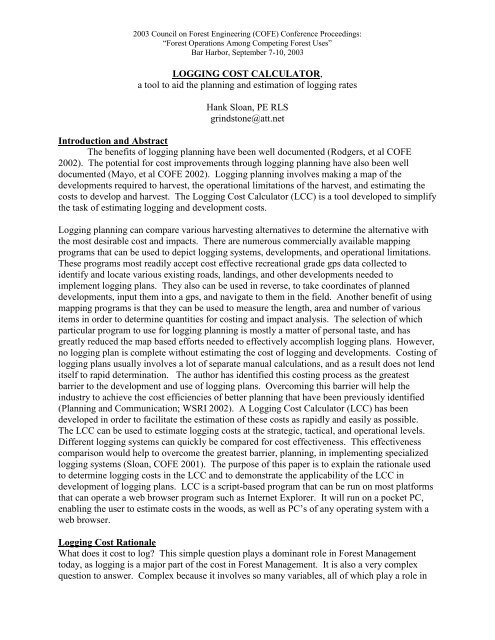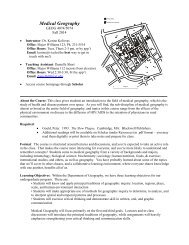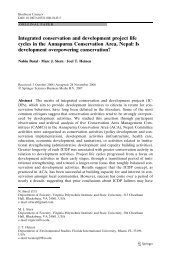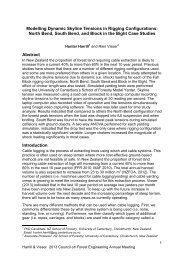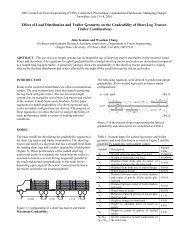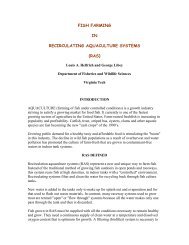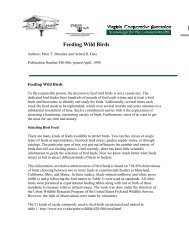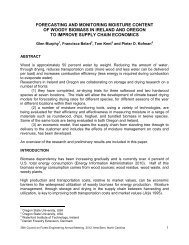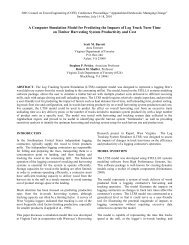Logging Cost Calculator, A Tool to Aid the Planning and Estimation ...
Logging Cost Calculator, A Tool to Aid the Planning and Estimation ...
Logging Cost Calculator, A Tool to Aid the Planning and Estimation ...
You also want an ePaper? Increase the reach of your titles
YUMPU automatically turns print PDFs into web optimized ePapers that Google loves.
2003 Council on Forest Engineering (COFE) Conference Proceedings:<br />
“Forest Operations Among Competing Forest Uses”<br />
Bar Harbor, September 7-10, 2003<br />
LOGGING COST CALCULATOR,<br />
a <strong>to</strong>ol <strong>to</strong> aid <strong>the</strong> planning <strong>and</strong> estimation of logging rates<br />
Hank Sloan, PE RLS<br />
grinds<strong>to</strong>ne@att.net<br />
Introduction <strong>and</strong> Abstract<br />
The benefits of logging planning have been well documented (Rodgers, et al COFE<br />
2002). The potential for cost improvements through logging planning have also been well<br />
documented (Mayo, et al COFE 2002). <strong>Logging</strong> planning involves making a map of <strong>the</strong><br />
developments required <strong>to</strong> harvest, <strong>the</strong> operational limitations of <strong>the</strong> harvest, <strong>and</strong> estimating <strong>the</strong><br />
costs <strong>to</strong> develop <strong>and</strong> harvest. The <strong>Logging</strong> <strong>Cost</strong> <strong>Calcula<strong>to</strong>r</strong> (LCC) is a <strong>to</strong>ol developed <strong>to</strong> simplify<br />
<strong>the</strong> task of estimating logging <strong>and</strong> development costs.<br />
<strong>Logging</strong> planning can compare various harvesting alternatives <strong>to</strong> determine <strong>the</strong> alternative with<br />
<strong>the</strong> most desirable cost <strong>and</strong> impacts. There are numerous commercially available mapping<br />
programs that can be used <strong>to</strong> depict logging systems, developments, <strong>and</strong> operational limitations.<br />
These programs most readily accept cost effective recreational grade gps data collected <strong>to</strong><br />
identify <strong>and</strong> locate various existing roads, l<strong>and</strong>ings, <strong>and</strong> o<strong>the</strong>r developments needed <strong>to</strong><br />
implement logging plans. They also can be used in reverse, <strong>to</strong> take coordinates of planned<br />
developments, input <strong>the</strong>m in<strong>to</strong> a gps, <strong>and</strong> navigate <strong>to</strong> <strong>the</strong>m in <strong>the</strong> field. Ano<strong>the</strong>r benefit of using<br />
mapping programs is that <strong>the</strong>y can be used <strong>to</strong> measure <strong>the</strong> length, area <strong>and</strong> number of various<br />
items in order <strong>to</strong> determine quantities for costing <strong>and</strong> impact analysis. The selection of which<br />
particular program <strong>to</strong> use for logging planning is mostly a matter of personal taste, <strong>and</strong> has<br />
greatly reduced <strong>the</strong> map based efforts needed <strong>to</strong> effectively accomplish logging plans. However,<br />
no logging plan is complete without estimating <strong>the</strong> cost of logging <strong>and</strong> developments. <strong>Cost</strong>ing of<br />
logging plans usually involves a lot of separate manual calculations, <strong>and</strong> as a result does not lend<br />
itself <strong>to</strong> rapid determination. The author has identified this costing process as <strong>the</strong> greatest<br />
barrier <strong>to</strong> <strong>the</strong> development <strong>and</strong> use of logging plans. Overcoming this barrier will help <strong>the</strong><br />
industry <strong>to</strong> achieve <strong>the</strong> cost efficiencies of better planning that have been previously identified<br />
(<strong>Planning</strong> <strong>and</strong> Communication; WSRI 2002). A <strong>Logging</strong> <strong>Cost</strong> <strong>Calcula<strong>to</strong>r</strong> (LCC) has been<br />
developed in order <strong>to</strong> facilitate <strong>the</strong> estimation of <strong>the</strong>se costs as rapidly <strong>and</strong> easily as possible.<br />
The LCC can be used <strong>to</strong> estimate logging costs at <strong>the</strong> strategic, tactical, <strong>and</strong> operational levels.<br />
Different logging systems can quickly be compared for cost effectiveness. This effectiveness<br />
comparison would help <strong>to</strong> overcome <strong>the</strong> greatest barrier, planning, in implementing specialized<br />
logging systems (Sloan, COFE 2001). The purpose of this paper is <strong>to</strong> explain <strong>the</strong> rationale used<br />
<strong>to</strong> determine logging costs in <strong>the</strong> LCC <strong>and</strong> <strong>to</strong> demonstrate <strong>the</strong> applicability of <strong>the</strong> LCC in<br />
development of logging plans. LCC is a script-based program that can be run on most platforms<br />
that can operate a web browser program such as Internet Explorer. It will run on a pocket PC,<br />
enabling <strong>the</strong> user <strong>to</strong> estimate costs in <strong>the</strong> woods, as well as PC’s of any operating system with a<br />
web browser.<br />
<strong>Logging</strong> <strong>Cost</strong> Rationale<br />
What does it cost <strong>to</strong> log? This simple question plays a dominant role in Forest Management<br />
<strong>to</strong>day, as logging is a major part of <strong>the</strong> cost in Forest Management. It is also a very complex<br />
question <strong>to</strong> answer. Complex because it involves so many variables, all of which play a role in
2003 Council on Forest Engineering (COFE) Conference Proceedings:<br />
“Forest Operations Among Competing Forest Uses”<br />
Bar Harbor, September 7-10, 2003<br />
establishing what it costs <strong>to</strong> log. These variables can easily lead <strong>to</strong> logging rates that vary by<br />
over 100%.<br />
The variables involve people, culture, equipment, <strong>to</strong>ols, location, wea<strong>the</strong>r, terrain, timber<br />
species, soils, size of tract, size of timber, methods of cut, markets or lack <strong>the</strong>reof (quotas),<br />
merchantability specifications, road construction <strong>and</strong> maintenance, time of year, performance<br />
st<strong>and</strong>ards (damage <strong>to</strong> residuals), planning effort, logging patterns, logging systems, <strong>and</strong> <strong>the</strong>re are<br />
many, more detailed, variables not listed. Many of <strong>the</strong>se variables can be determined with a<br />
good logging plan, o<strong>the</strong>rs cannot. For example, tract size, tract volume, tree size, species, road<br />
construction <strong>and</strong> maintenance, l<strong>and</strong>ings, yarding distances, slopes, haul routes <strong>and</strong> times <strong>to</strong><br />
various markets, time of year for harvest, <strong>and</strong> <strong>the</strong> selected logging system can be determined<br />
from a logging plan.<br />
O<strong>the</strong>r variables, such as people, work culture, <strong>and</strong> condition of equipment cannot be specifically<br />
determined, but can be reasonably assessed. Some equipment is maintenance heavy (i.e. lemon)<br />
<strong>and</strong> some equipment seems <strong>to</strong> run forever. Some loggers are highly motivated <strong>to</strong> optimize <strong>the</strong>ir<br />
production <strong>and</strong> o<strong>the</strong>rs are content with st<strong>and</strong>ards that permit survival. Loggers have a tendency<br />
<strong>to</strong> self compensate <strong>the</strong>ir production efforts, clouding fur<strong>the</strong>r <strong>the</strong> effect of <strong>the</strong> true variability in<br />
logging costs. For example working longer days in order <strong>to</strong> compensate for more difficult<br />
chances, <strong>and</strong>/ or loosing money on a tract <strong>and</strong> making money on <strong>the</strong> next <strong>to</strong> dilute <strong>the</strong> true<br />
variability of logging costs.<br />
What does it cost <strong>to</strong> log? The answer <strong>to</strong> this simple question also depends on <strong>the</strong> scale <strong>and</strong> scope<br />
of <strong>the</strong> question. For example, what did it cost <strong>to</strong> log your mill last year should be a fairly simple<br />
question <strong>to</strong> answer by <strong>to</strong>taling <strong>the</strong> costs <strong>and</strong> volume logged <strong>and</strong> dividing. Answering <strong>the</strong><br />
question, what should it have cost <strong>to</strong> log your mill is a difficult question <strong>to</strong> answer <strong>and</strong> involves<br />
analysis of all of <strong>the</strong> variables listed above. The best question <strong>to</strong> ask is: Are my logging costs<br />
reasonable?<br />
When looking at logging costs <strong>and</strong> productivity it is important <strong>to</strong> remember that in this mix of<br />
loggers <strong>the</strong>re are “star” performers as well as “also ran” performers. When answering <strong>the</strong><br />
question, it would be a mistake <strong>to</strong> establish ei<strong>the</strong>r one of <strong>the</strong>se extremes as <strong>the</strong> performance<br />
st<strong>and</strong>ard. What is important about a logging cost performance level is that it is reasonable. In<br />
this manner <strong>the</strong> “stars” are rewarded <strong>and</strong> <strong>the</strong> “also rans” are penalized. This is one of <strong>the</strong><br />
problems with using productivity <strong>and</strong> cost from most classical time <strong>and</strong> motion studies, <strong>the</strong>y just<br />
give a snapshot of an operation <strong>and</strong> invariably it is of a “star” or an “also ran” performer, in<br />
conditions that are particular <strong>to</strong> <strong>the</strong> tract being harvested. In 1997 <strong>the</strong> World Forest Institute<br />
developed a logging cost estima<strong>to</strong>r in which <strong>the</strong> productivity of a particular operation was<br />
presented as a range for <strong>the</strong> user <strong>to</strong> reasonably estimate (Wilbrect, 1997). This program presents<br />
a production range of what could be considered reasonable, <strong>and</strong> permits <strong>the</strong> user <strong>to</strong> evaluate<br />
logging costs over that range. While this program does not contain enough detail <strong>to</strong> evaluate a<br />
wide range of logging conditions, it does recognize <strong>the</strong> difficulty in estimating productivity.<br />
Virtually every logging cost method I have ever used has required me <strong>to</strong> “cus<strong>to</strong>mize <strong>the</strong> results”<br />
with judgment gained through experience. The productivity levels in <strong>the</strong> LCC are based upon<br />
experience in what is reasonable <strong>to</strong> achieve given all <strong>the</strong> particulars of a logging job. This
$/Mbf<br />
2003 Council on Forest Engineering (COFE) Conference Proceedings:<br />
“Forest Operations Among Competing Forest Uses”<br />
Bar Harbor, September 7-10, 2003<br />
judgment can be easily be adjusted <strong>to</strong> account for being smarter <strong>to</strong>morrow than one is <strong>to</strong>day, as<br />
we are constantly learning about logging productivity.<br />
It has been my experience that actual contract logging rates do not accurately reflect <strong>the</strong> work<br />
that is involved with logging a particular tract. The typical logging rate structure is flatter than<br />
what reasonable estimates would conclude. This flatness involves under estimating contract<br />
rates on poor tracts <strong>and</strong> over estimating contract rates on good tracts. When it comes <strong>to</strong> sealed<br />
bid timber sales, this flatness leads <strong>to</strong> underbidding on <strong>the</strong> good tracts <strong>and</strong> overbidding on <strong>the</strong><br />
poor tracts, of course at <strong>the</strong> loggers expense! This is a loose - loose situation where <strong>the</strong>re is<br />
obviously an incentive <strong>to</strong> more accurately estimate <strong>the</strong> true range of logging costs.<br />
250<br />
200<br />
150<br />
100<br />
50<br />
0<br />
200<br />
0<br />
No<br />
Plan<br />
<strong>Logging</strong> <strong>Cost</strong><br />
190<br />
180<br />
10<br />
Min<br />
Plan<br />
180<br />
160 160<br />
20<br />
Good<br />
Plan<br />
<strong>Planning</strong> Effort<br />
190<br />
30<br />
Over<br />
Plan<br />
<strong>Planning</strong><br />
Log Rate<br />
Total<br />
What does it cost <strong>to</strong> log? The answer<br />
<strong>to</strong> this question should include <strong>the</strong><br />
cost of planning for logging. So <strong>the</strong><br />
answer has two parts, 1) planning<br />
cost <strong>and</strong> 2) contract logging rate.<br />
The <strong>to</strong>tal of <strong>the</strong>se two is <strong>the</strong> answer<br />
<strong>to</strong> <strong>the</strong> question. Opportunities for<br />
increased productivity through better<br />
logging planning have been<br />
identified through extensive study<br />
funded by WSRI (Rodgers, 2002). A<br />
relationship between planning effort<br />
<strong>and</strong> logging costs is: as more effort is<br />
put in<strong>to</strong> optimizing <strong>and</strong> developing<br />
logging plans, <strong>the</strong> more efficient<br />
logging becomes. As one can see in<br />
<strong>the</strong> chart, with increasing amounts of<br />
planning, <strong>the</strong> reasonable contract rate<br />
for logging decreases. At some point<br />
in planning effort, <strong>the</strong> logging<br />
efficiency in maximized <strong>and</strong> any<br />
fur<strong>the</strong>r investment in logging<br />
planning will result in an overall<br />
increase in <strong>to</strong>tal logging cost. This<br />
effect of increased planning leading<br />
<strong>to</strong> decreased logging rate works at both a strategic scale as well as a tactical scale. Strategic<br />
logging planning is not site specific, but is a broad based consideration of timber <strong>and</strong> terrain<br />
resulting in optimal logging system selection <strong>and</strong> that systems application guidelines. Strategic<br />
logging planning pays off by putting <strong>the</strong> right <strong>to</strong>ol on <strong>the</strong> job. Tactical logging plans are sitespecific<br />
development plans for a particular logging system. Tactical logging planning pays off<br />
by making <strong>the</strong> most efficient use of <strong>the</strong> <strong>to</strong>ol.<br />
How much planning effort is optimal? Depends on all <strong>the</strong> aforementioned variables, but<br />
spending somewhere around 10 – 15% of <strong>the</strong> <strong>Logging</strong> Rate would be a reasonable place <strong>to</strong> start.<br />
Generally <strong>the</strong> lower cost <strong>the</strong> logging, <strong>the</strong> less opportunity <strong>to</strong> reduce overall costs by improved
2003 Council on Forest Engineering (COFE) Conference Proceedings:<br />
“Forest Operations Among Competing Forest Uses”<br />
Bar Harbor, September 7-10, 2003<br />
planning, however <strong>the</strong>re are exceptions, such as helicopter logging which has a high unit rate but<br />
relatively easy <strong>to</strong> plan <strong>and</strong> optimize. A good starting point is 10 – 15%, which can be refined by<br />
actual experience in <strong>the</strong> area.<br />
The LCC – what it is<br />
The LCC is a <strong>to</strong>ol which calculates road <strong>and</strong> logging costs on a per unit of volume <strong>and</strong> weight<br />
basis, taking in<strong>to</strong> account all of <strong>the</strong> variables which can be determined or estimated for a<br />
particular logging chance <strong>and</strong> making a reasonable estimate of system productivity.<br />
Having completed many strategic <strong>and</strong> tactical logging plans, I was frustrated by <strong>the</strong> time<br />
involved <strong>and</strong> organizational skills needed <strong>to</strong> go <strong>to</strong> many different places in order <strong>to</strong> estimate<br />
costs of each plan. The objective of developing <strong>the</strong> LCC was <strong>to</strong> produce a one-s<strong>to</strong>p shop for<br />
costing logging plans. With <strong>the</strong> idea of using a popup window <strong>to</strong> be used concurrently with a<br />
mapping program, <strong>and</strong> portability outside of lap<strong>to</strong>p environment, I decided <strong>to</strong> use Internet<br />
Explorer <strong>and</strong> code pages with JavaScript. LCC will run on Pocket PC’s. The script is written <strong>to</strong><br />
be easily updated or tweaked as more experience is gained. The script was written <strong>to</strong> take<br />
advantage of costing methods <strong>and</strong> principles <strong>the</strong> author has learned from years of experience in<br />
developing logging costs. LCC includes on a drop down menu <strong>to</strong> select from 11 different<br />
logging systems <strong>and</strong> 4 swing applications, truck roads including culverts, skid<br />
roads, revegetation costs <strong>and</strong> o<strong>the</strong>r developments. The logging systems are: 1)<br />
Grapple Skidder, 2) Cable Skidder, 3) Grapple Tracks, 4) Cable Tracks, 5) Cut<br />
<strong>to</strong> Length, 6) Fully Mechanized, 7) Shovel, 8) Skyline – Shovel, 9) Skyline –<br />
Skidder, 10) Helicopter, 11) Horse <strong>and</strong> for swing only 12) Forwarder, 13)<br />
Tracks Grapple, 14) Tracks Cable, <strong>and</strong> 15) Shovel. Full description of each<br />
system is provided through an extensive help system. System productivity is<br />
limited by ei<strong>the</strong>r hauling capacity or logging capacity, <strong>and</strong> requires manual adjustment <strong>to</strong><br />
balance. Use of <strong>the</strong> LCC is designed <strong>to</strong> be self-explana<strong>to</strong>ry.<br />
Instructions on how <strong>to</strong> use<br />
Select <strong>the</strong> logging system that you are planning for from <strong>the</strong> drop down listing. 2) Fill in <strong>the</strong> data<br />
variables for <strong>the</strong> logging plan you are costing. 3) Click <strong>the</strong> but<strong>to</strong>n <strong>and</strong> logging cost <strong>and</strong><br />
production is listed in <strong>the</strong> boxes at <strong>the</strong> bot<strong>to</strong>m. The page may be printed <strong>to</strong> document your costs<br />
<strong>and</strong> variables. If <strong>the</strong> window is not big enough <strong>to</strong> view <strong>the</strong> results, go <strong>to</strong> view – text size – <strong>and</strong><br />
change <strong>to</strong> smaller. Since this process is so simple, it encourages comparisons between<br />
alternative logging plans for <strong>the</strong> same system as well as comparison between logging systems.<br />
Help is available by clicking <strong>the</strong> question mark but<strong>to</strong>n located beside <strong>the</strong> variable being asked<br />
for. Note that logging costs are determined for <strong>the</strong> limiting production of ei<strong>the</strong>r hauling or cut<br />
skid <strong>and</strong> load (CSL). Balancing this production will result in <strong>the</strong> lowest cost logging. The best<br />
way <strong>to</strong> explain how <strong>the</strong> logging cost calcula<strong>to</strong>r works is by showing some example applications.<br />
Example 1) Tactical optimization on a system. The logging system planned for is a cable<br />
skidder with manual falling <strong>and</strong> 2 haul trucks. The logging plan indicates that <strong>the</strong> tract is 40 acre<br />
has 320 mbf with an average tree of 200 bf, typical hardwood mix. The plan is <strong>to</strong> skid <strong>to</strong> <strong>the</strong><br />
edge of <strong>the</strong> tract with an average skid of 900 feet on pretty gentle ground (15% adverse skid),<br />
<strong>and</strong> each truck can haul 2 loads per day. It is estimated that 1600 ft of skid trail will need <strong>to</strong> be<br />
revegetated <strong>and</strong> <strong>the</strong> average side slope at <strong>the</strong> roadside l<strong>and</strong>ing is 25%. The LCC calculates <strong>to</strong>tal
2003 Council on Forest Engineering (COFE) Conference Proceedings:<br />
“Forest Operations Among Competing Forest Uses”<br />
Bar Harbor, September 7-10, 2003<br />
logging costs <strong>to</strong> be $193/mbf. If <strong>the</strong> logger builds a road <strong>to</strong> <strong>the</strong> middle of <strong>the</strong> tract, about 600<br />
feet, will he be better off? The logging plan indicates <strong>the</strong> road average side slopes are 25%, will<br />
need spot surfacing, <strong>and</strong> it will have 2 ea 18” culverts at a cost of $360 ea. The average skid is<br />
reduced <strong>to</strong> 550 feet. The LCC calculates <strong>to</strong>tal logging costs <strong>to</strong> be $170/mbf, including <strong>the</strong><br />
$4.90/mbf for <strong>the</strong> road. Since this was such a good deal, <strong>the</strong> logger thinks he can save even more<br />
by building 300 feet more of road <strong>and</strong> reducing his average skid <strong>to</strong> 400 feet, working 2 l<strong>and</strong>ings.<br />
The LCC calculates $172/mbf, so <strong>the</strong> logger decides <strong>to</strong> not spend <strong>the</strong> extra on <strong>the</strong> road, <strong>and</strong><br />
negotiates for a $180/mbf rate (5% profit).<br />
Example 2) <strong>Logging</strong> System Selection. An eastern hardwood sawmill owner has seen a skyline<br />
logging operation out west during his Elk hunting trip. He liked <strong>the</strong> skyline system because it<br />
can produce logs when <strong>the</strong> wea<strong>the</strong>r is adverse <strong>to</strong> his normal logging operations. He is trying <strong>to</strong><br />
figure out if it would be cost effective against his normal skidder crews on some of <strong>the</strong> ground he<br />
is logging. He has taken a sample of several of <strong>the</strong> tracts he is logging <strong>and</strong> completed a logging<br />
plan for both his skidders <strong>and</strong> for a skyline – shovel operation. From <strong>the</strong>se plans he has<br />
determined <strong>the</strong> following strategic information. The average tract size is 123 acres, needs .93<br />
miles of truck road on average side slope of 30%, needs 3.2 miles of skid road on average side<br />
slope of 50+%, needs 4 l<strong>and</strong>ings, <strong>and</strong> has 3.6 mbf/ acre cut common hardwoods (14#/bf),<br />
average tree is 275 bft, <strong>and</strong> cable skidding mainly downhill on a modest road grade of -15%<br />
average 900 feet is normal. Each of <strong>the</strong> 2 assigned trucks can haul 3 loads/day. The LCC<br />
indicates his costs <strong>to</strong> be $198/mbf. He is shocked, <strong>and</strong> so thinks immediately about getting a<br />
grapple skidder <strong>and</strong> keeping<br />
<strong>the</strong> same logging plan. The<br />
LCC indicates his cost drop <strong>to</strong><br />
$171/mbf, so he orders one,<br />
but <strong>the</strong>n starts <strong>to</strong> think about<br />
all <strong>the</strong> uphill pulling <strong>and</strong> how<br />
<strong>the</strong> cable skidder comes in<br />
h<strong>and</strong>y being able <strong>to</strong> winch.<br />
So, wondering where <strong>the</strong><br />
uphill skidding limit for his<br />
new grapple skidder is, he<br />
consults <strong>the</strong> LCC <strong>and</strong> figures<br />
that somewhere around a 20%<br />
adverse <strong>and</strong> steeper grade <strong>the</strong><br />
cable skidder is cheaper. He<br />
vows <strong>to</strong> keep his new grapple<br />
skidder on grapple skidder<br />
ground <strong>and</strong> moves on <strong>to</strong> his<br />
real problem, <strong>to</strong> figure out<br />
how much is it going <strong>to</strong> cost <strong>to</strong><br />
skyline log? Back <strong>to</strong> those<br />
strategic logging plans he<br />
developed for a skyline –<br />
shovel on <strong>the</strong> rougher ground<br />
<strong>and</strong> has determined <strong>the</strong>
2003 Council on Forest Engineering (COFE) Conference Proceedings:<br />
“Forest Operations Among Competing Forest Uses”<br />
Bar Harbor, September 7-10, 2003<br />
following: On <strong>the</strong> typical 123 acre tract, about 57% (70 acres) of it lent itself <strong>to</strong> skyline an<br />
average of 650 feet uphill, needed 1.3 miles of truck road, needed 1.1 mile of skid road, <strong>and</strong><br />
needed 5 l<strong>and</strong>ings with 7 corridors per l<strong>and</strong>ing <strong>and</strong> no planned tail tree rigging. So by adding in<br />
<strong>the</strong> skyline, truck road construction went up by 36% (1950 ft), skid road construction went down<br />
by 65% (-11088 ft), <strong>and</strong> l<strong>and</strong>ing construction went up by 25% (+1 ea). Consulting <strong>the</strong> LCC he<br />
finds that a skyline – shovel system would cost an average of $190/mbf for <strong>the</strong> increased truck<br />
road <strong>and</strong> logging, but it would also save $43/mbf on saved skid roads <strong>and</strong> revegetation, leaving<br />
<strong>the</strong> net cost impact of $147. This cost is less than current costs, so he decides <strong>to</strong> pursue getting a<br />
skyline – shovel system. He also figures that his skidder production will get better by keeping it<br />
on ground more suited <strong>to</strong> it.<br />
Example 3) Merchantability – Markets Logger is trying <strong>to</strong> decide how small should he<br />
merch<strong>and</strong>ize <strong>to</strong> a sawtimber market. Sawtimber market is 50 miles away, or a 3 load/day haul.<br />
Pulpwood market is 30 miles away <strong>and</strong> is a 4 load/day haul. Sawtimber market pays $200/mbf<br />
Doyle scale <strong>and</strong> pulpwood pays $26/<strong>to</strong>n after stumpage is taken out. The logging plan is for a<br />
skyline/ shovel job of 30 acres, 300 mbf <strong>to</strong>tal (heavy <strong>to</strong> Yellow Poplar), 275 bf/tree, <strong>and</strong> an<br />
average yard of 700 feet <strong>and</strong> 2 l<strong>and</strong>ings <strong>and</strong> 20 skyline<br />
roads. It will take 1000 ft of road on 35% side slopes<br />
<strong>and</strong> no culverts. The LCC <strong>to</strong> <strong>the</strong> pulpwood market is<br />
$17.30/<strong>to</strong>n (110.71/mbfeq) <strong>and</strong> $114.01/ mbf<br />
($17.81/<strong>to</strong>n eq) <strong>to</strong> <strong>the</strong> sawtimber market. Gross<br />
revenue pulpwood is $26 - $17.30 = $8.70/ <strong>to</strong>n, gross<br />
revenue sawtimber is $200 - $114.01 = $85.99. The<br />
breakeven is ($85.99/mbf) / ($8.70/<strong>to</strong>n) = 9.9 <strong>to</strong>n/mbf.<br />
If <strong>the</strong> timber weights 10 <strong>to</strong>ns per mbf or heavier <strong>the</strong>n<br />
pulpwood brings more revenue. What trees should be<br />
merch<strong>and</strong>ized as pulpwood? Using <strong>the</strong> LCC density<br />
calcula<strong>to</strong>r one can determine that <strong>the</strong> heavy<br />
hardwoods of good form (65# & FC80), 12.9” dbh<br />
<strong>and</strong> smaller should go <strong>to</strong> pulpwood; in <strong>the</strong> light<br />
hardwoods of good form (52.5# & FC80), 11.1” dbh<br />
<strong>and</strong> smaller should go <strong>to</strong> pulpwood. If <strong>the</strong> timber is of<br />
poor form, FC78, this breakeven changes <strong>to</strong> 13.6” for<br />
<strong>the</strong> heavy hardwoods <strong>and</strong> 11.7” dbh for <strong>the</strong> soft<br />
hardwoods. What happens if logs have a scaling<br />
deduction of 20%? Then I am looking for a log whose<br />
size is such that 120% of it <strong>to</strong>ns/ bf is 10, so 10/1.2 = 8.3 <strong>to</strong>ns/bf. The breakeven for <strong>the</strong> heavy<br />
hardwoods with poor form <strong>and</strong> a 20% scaling deduction is 16.1”dbh<br />
Conclusion<br />
One of <strong>the</strong> greatest improvements <strong>to</strong> <strong>the</strong> cost <strong>and</strong> impacts of forest management can be made<br />
through better logging plans. Generating logging costs for a mapped out logging plan is a<br />
significant barrier <strong>to</strong> developing logging plans. Awareness of alternatives <strong>to</strong> conventional<br />
logging systems is a first step <strong>to</strong>wards better matching <strong>the</strong> timber <strong>and</strong> terrain with <strong>the</strong> proper<br />
logging system. The LCC can assist foresters, loggers, <strong>and</strong> forest management people <strong>to</strong> make<br />
better decisions.
2003 Council on Forest Engineering (COFE) Conference Proceedings:<br />
“Forest Operations Among Competing Forest Uses”<br />
Bar Harbor, September 7-10, 2003<br />
Wilbrect, S. 1997. A Guide <strong>to</strong> Estimating <strong>Logging</strong> <strong>Cost</strong>s in <strong>the</strong> Pacific Northwest (PNW). World<br />
Forest Institute publication.<br />
Rodgers, B et al 2002. Opportunities for Increasing Productivity in <strong>the</strong> Industrial Wood Supply<br />
Chain through improved <strong>Planning</strong>. COFE 2002 Auburn Al<br />
Mayo, J.H. et al 2002. Causes <strong>and</strong> <strong>Cost</strong>s of Unused <strong>Logging</strong> Production Capacity. COFE 2002<br />
Auburn AL<br />
Sloan, H 2001. Appalachian Hardwood <strong>Logging</strong> Systems: Managing Change for Effective BMP<br />
Implementation. COFE 2001 Snowshoe WV


